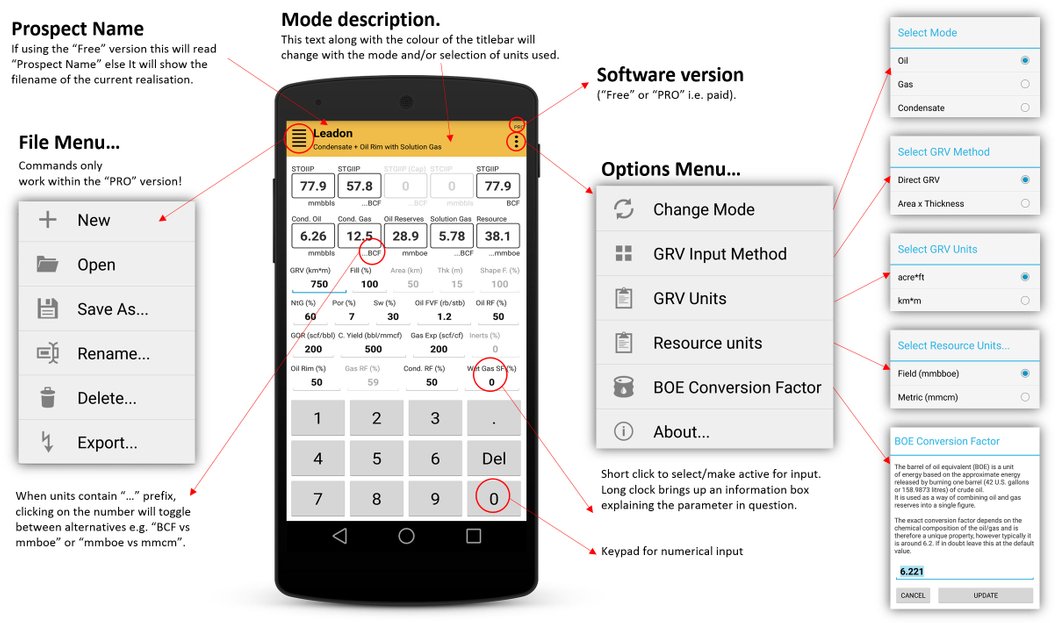chapter24
This app calculates hydrocarbon stocktank volumes and recoverable resources for oil fields and exploration prospects. Written by an experienced exploration geologist it addresses a direct need for quick HCIIP calculations when away from your desk.
The app is able to handle separate oil, gas and condensate phases, as well as mixtures of all three including gas caps and oil rims. GRV (Gross Rock Volume) can be entered directly or as "Area x Thickness x Shape Factor” and input volume units can be handled in Field (acre*ft) or Metric (km*m) units. Final resource totals can be displayed in either Field (mmboe) or Metric (mmcm) units.
The FREE version removes the file handling capabilities available in the paid (Pro) version which allows for the saving, retrieval and export of your analysis. Apologies if you feel that this hobbles the app, but the free version is intended to demonstrate the functionality in order to encourage the purchase of the paid version.
Please support the author and his hard work. so if you use the app why not pay for it and get all the PRO features!
Instructions
HCIIP Explained
The HCIIP is an acronym for Hydrocarbons Initially In Place. For Oil this is STOIIP (Stock Tank Oil Initially In Place) and for Gas it’s GIIP (Gas Initially In Place).
HCIIP a function of the Gross Rock volume (GRV) multiplied by the Net to Gross (NTG), Porosity (POR) and Oil or Gas Saturation (Shc). All these fractions are used to discount any volume of the GRV that does not add to the Hydrocarbon volume. Furthermore HCIIP is not the volume of hydrocarbons in the reservoir, but at stock tank (at the surface) conditions. Hence the name STOIIP: Stock Tank Oil Initially In Place when talking about Oil. For gas the name is just GIIP.
To calculate stock tank conditions the temperature, composition and pressure of the fluids in the reservoir is used to calculate a Formation Volume Factor. This factor is used to express the expansion of the gas when brought to surface. For oil it is used to express the volume decrease due to gas escaping from the fluid when the pressure drops.
Please note that the HCIIP is not the volume that is eventually produced as no reservoir can be produced to the last drop of Oil or Gas. The recovery Factor is a last factor that can be used to estimate the recoverable volume of Hydrocarbons but is very much dependent on the development method for the field.
Definitions
Area (acre*ft or km2)
Area componant used to calculate the GRV when using the 'Area x Thickness' input method.","Area").
bbls
Barrels of liquid (typically oil volume).
BCF
Billions of cubbic feet (gas volume).
BOE Conversion Factor
The barrel of oil equivalent (BOE) is a unit of energy based on the approximate energy released by burning one barrel (42 U.S. gallons or 158.9873 litres) of crude oil.
It is used as a way of combining oil and gas reserves into a single figure. The exact conversion factor depends on the chemical composition of the oil/gas and is therefore a unique property, however typically it is around 6.2. If in doubt leave this at the default value.
Condensate/Gas Ratio (bbls/mmcf)
This is a measure of the amount of Natural Gas Liquids (NGL) that are liberated from a wet gas at surface conditions. The exact figure is a direct property of the PVT (Pressure Volume Temperature) componant of the gas and is therefore unique in each case. Approximations can however be made and assumptions based on near field analogues. Typically this parameter declines over time, so this figure must represent a typical average over the production life of a field.
Condensate Recovery Factor (%)
Recovery efficiency of Condensate component measured as a % of Stocktank Volume. Values are typically in the range 60-80%, but can occasionally get as high as 90%+ in exceptional circumstances.
Dry Gas Shrinkage Factor (%)
Accounts for the gas shrinkage that occurs through subtraction of the liquid portion.
Fill (%)
Percenatage of the GRV componant filled by hydrocarbons. Used as an easy way to vary the resource calculation i.e. the maximum GRV of a 4-way closed feature can be entered, and varying spill points can be played with to understand the resulting resource calculation.
Gas Cap (%)
Proportion of the Gross Rock Volume (GRV) that composes the Gas Cap.
Gas Expansion Factor (scf/bbl)
Similiar to the Oil FVF, this relates the volume of gas in the reservoir to that of the produced volume at standard conditions. Unlike the Oil FVF, the inverse value (Gas Expansion Factor) is often used As the units are easier To handle.
GIIP
Gas initially In Place.
Gas/Oil Ratio (scf/bbl)
Gas/Oil Ratio (GOR) is the ratio of the volume of gas that comes out of solution, to the volume of oil at standard conditions. The volume of oil will therefore shrink slightly after the gas has been liberated. The units are therefore a ratio of standard cubic feet of gas (scf) per barrel of oil (bbl).
Gas Recovery Factor (%)
Recovery efficiency of Gas component measured as a % of Stocktank Volume. Values are typically in the range 60-80%, but can occasionally get as high as 90%+ in exceptional circumstances.
Geometric Correction Factor (%)
Geometric Correction Factor applies to calculated rock volumes to account for the pinchout of a hydrocarbon column at the edges of a prospect. Affected by the gross sectional shape of the prospect, its end members are a rounded dome (half a soccer ball), which is strongly discounted with a factor of 0.5 (50%), and a slab which is not discounted at all with a factor of 1 (100%). In between there is a flat-topped container (like an inverted soup dish).
GRV (acre*ft or km2*m)
Stands for Gross rock volume and is the volume of rock in the trap above the hydrocarbon water contact.
HCPV
Stands for Hydrocarbon Pore volume and is the volume of oil or gas filled intragranular pores in the trap above the hydrocarbon water contact with non-reservoir rock discounted. This done by multiplying NPV (=NRV*POR) with Shc. This Shc is the average saturation of the hydrocarbons in the pores, usually 1-Sw (water saturation).
Inerts (%)
Proportion of the gas phase that is composed of non salable hydrocarbons, typically inert compounds such as CO2 (Carbon Dioxide), SO2 (Sulphur Dioxide). Only really effects certain fields in areas of known CO2 presence etc, so usally can be left at 0%.
mmbbls
Million of barrels (volume of oil).
mmboe
Million barrels of oil equivalent (combined volume of Oil, Gas or Condensate i.e total hydrocarbon volume).
NPV
Stands for Net Pore volume and is the volume of fluid or gas filled intragranular pores in the trap above the hydrocarbon water contact with non-reservoir rock discounted. This done by multiplying NRV (=GRV*NTG) with POR. The POR does need to be the average porosity in the net reservoir, usually called PORNET and is somewhere between 0 to 45%.
NRV (%)
Stands for Net rock volume and is the volume of rock in the trap above the hydrocarbon water contact with non-reservoir rock discounted. This done by multiplying GRV with Net to Gross (see below).
Net to Gross (%)
'Net to Gross' specifies the amount of Net Rock Volume (NRV) as a proportion (%) of the Gross Rock Volume (GRV). Typically this is defined using a 1mD/10-12% Porosity cut off. i.e rock that fails to meet the criteria is considered 'Non Net' and therefore not part of the resulting STOIIP calculation.
Porosity (%)
Porosity is the proportion (%) of reservoir rock containing the 'Effective Porosity' componant, i.e. the % of rock (void space) which can retain a liquid.
Oil Formation Volume Factor (bbl/stb)
Oil Formation Volume Factor (FVF) relates to the volume of oil at stock-tank conditions to the volume of oil at elevated pressure and temperature in the reservoir. Units are therefore a ratio of reservoir barrels (bbl) to stocktank barrels (stb). Oil formation volume factors are almost always greater than 1.0 because the oil in the formation usually contains dissolved gas that comes out of solution in the wellbore with dropping pressure.
Oil Recovery Factor (%)
Recovery efficiency of Oil component measured as a % of Stocktank Volume. Values are typically in the range 20-40%, but can occasionally get as high as 50%+ in exceptional circumstances.
OIIP
Oil Initiallty In Place.
Oil Rim (%)
Proportion of the Gross Rock Volume (GRV) that composes the Oil Rim.
Thickness (ft or m)
Thickness componant used to calculate the GRV when using the 'Area x Thickness' input method.
Wet Gas Shrinkage Factor (%)
Accounts for the gas shrinkage that occurs through subtraction of the liquid portion.
STOIIP
Stock Tank of Oil Initiallty In Place.
Water Saturation (%)
Water Saturation is the % of porosity (void space) which contains formation water. The inverse of this % is calculated and assumed to hold the hydrocarbon (gas/oil/condensate) componant.



